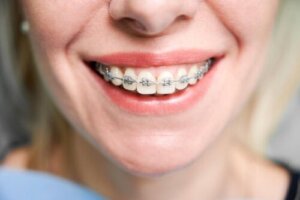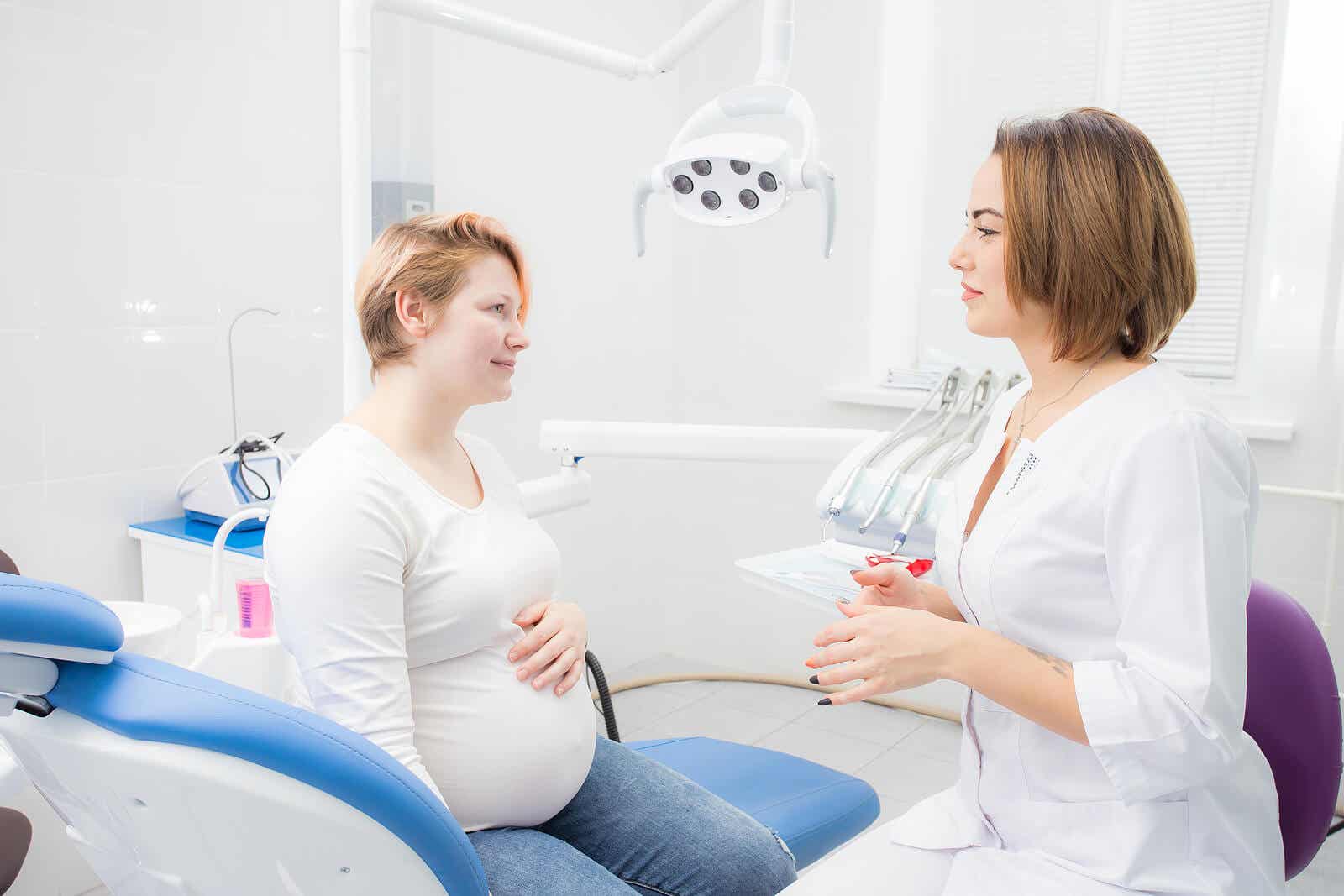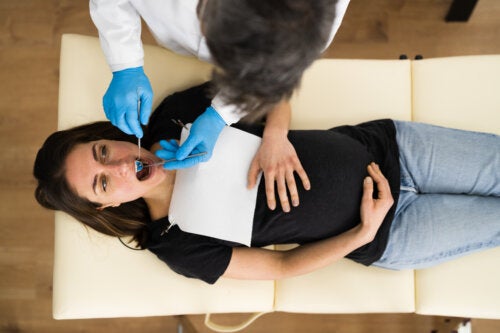Is Orthodontics During Pregnancy Safe?


Written and verified by the dentist Vanesa Evangelina Buffa
The trend to have a beautiful and aligned smile has led more and more adults to wear braces in their mouths to improve their bite. With this, the concern arises as to whether orthodontics is possible during pregnancy.
At this stage, a woman’s body undergoes many changes, and these changes can also affect the health of her mouth. It’s common for pregnant women to have a higher risk of developing cavities and gum problems. However, this doesn’t mean that dental treatments can’t be performed to correct bite problems.
Orthodontics during pregnancy
On its website, the Spanish Society of Orthodontics and Dentofacial Orthopedics (SEDO) explains that there’s no contraindication to using dental appliances in pregnant women. However, it’s essential that the woman indicates to the orthodontist that she’s expecting a baby, could be pregnant, or is looking to conceive.
In this way, the professional will take the appropriate care to ensure the safety of the expectant mother and the fetus. An article published in the International Journal of Medical Dentistry highlights that, with good communication between the health workers and the patient, it’s possible to carry out adequate orthodontic treatments in a healthy pregnant woman.
However, due to the changes inherent to pregnancy, there are some special considerations that the orthodontist must take into account in the management of their pregnant patient. We’ll tell you about them below.

Dental X-rays in pregnancy
When performing orthodontics, the study of the mouth and the planning of therapy require the use of X-rays of the inside and outside of the mouth. Although these are low levels of radiation and the evidence suggests that these practices don’t affect the fetus, their use should be limited during pregnancy, especially in the first trimester.
For this reason, if you’re pregnant and haven’t yet started orthodontics, it’s ideal to postpone aligning your smile until after delivery. If, on the other hand, you’re already wearing your braces during pregnancy, there’s no need to interrupt treatment, and you can continue as normal.
In any case, if there’s a need to take any X-rays as part of the treatment, you should remind the professional about your condition. The orthodontist will provide adequate protection with leaded smocks and minimal radiation.
It’s worth clarifying that the photographs and molds taken in orthodontic practices don’t pose any risk during pregnancy.
The time of pregnancy
In the first weeks of pregnancy, it’s common for women to experience nausea and vomiting. If we add to this the need to keep your mouth open during orthodontic visits, the rubbing of the wires, and the pressure of the appliances, the discomfort may increase.
The second trimester of pregnancy is the most opportune time to perform the necessary dental treatments. Procedures that can’t wait until after delivery, such as exodontia for orthodontics, can be planned at this time.
An article in the International Journal of Applied Dental Sciences recommends coordinating the orthodontic treatment plan with the woman’s obstetrician. In this way, it’s possible to establish guidelines that will benefit oral health, maternal well-being, and perinatal outcomes.
In late pregnancy, the increased size of the uterus and the discomfort of the last few weeks can make orthodontic checkups difficult. Short appointments and avoiding the supine position are preferred.
Oral health and orthodontics during pregnancy
Oral health can be affected by the changes of pregnancy:
- Hormonal variations and increased irrigation of oral tissues.
- Difficulties in maintaining proper oral hygiene
- Reflux and nausea
- Changes in diet and a preference for sweet foods
Some studies report a greater susceptibility of pregnant women to periodontal problems such as gingivitis and periodontitis. Likewise, it’s common for them to have a higher risk of suffering cavities. To avoid these diseases, it’s essential to control bacterial plaque with proper oral hygiene.
The presence of appliances in the mouth is a factor that can aggravate the predisposition of pregnant women to suffer from these oral health complications. Wires and brackets tend to retain bacteria that increase the risk of cavities and gum inflammation.
The discomfort caused by braces
During the first days of wearing braces, it’s common for patients to feel discomfort and even pain in the mouth due to the pressure exerted by the attachments on the teeth. The rubbing of the wires against the mucous membranes can cause injuries that can also cause discomfort.
The pain and discomfort caused by the appliances can lead a person to avoid eating because of the discomfort they feel. This situation is problematic in a pregnant woman, in which feeding plays a fundamental role in the normal development of the developing baby.
The professional should consider these situations in the orthodontic treatment of the pregnant woman and minimize them. In these cases, the use of the appliances mustn’t affect the correct nutrition of the mother-to-be.
Should orthodontics be interrupted during pregnancy?
If pregnancy occurs during orthodontic treatment, you shouldn’t worry; there’s no contraindication. You can go ahead with the alignment of your teeth, but, as we’ve told you, there’ll be some special care that you should consider.
On the other hand, if you’re pregnant and want to start treatment with braces, it’s advisable to wait until the baby’s born to start orthodontics. The need for X-rays, the period of adaptation to the appliances, and the changes in your oral tissues make it more complicated to start dental therapy at this stage.
Which dental appliance is more convenient during pregnancy?
The type of appliance used depends on many factors and is a decision that you’ll make together with your orthodontist. If you’re thinking of having a baby when you start orthodontics, it’s important to let your orthodontist know. This way, they can suggest an appliance that adapts to your needs and projections.
Because brackets and wires in the mouth can cause damage to the oral mucosa and retain bacterial plaque, the orthodontist may suggest treatment with invisible aligners, such as Invisalign®. These are removable devices that are changed progressively and exert pressure on the teeth to align them.
With this type of appliance, hygiene is easier, as you only need to remove the aligner and clean them regularly. Also, as there are no wires and tips, uncomfortable mucosal wounds are avoided.

Taking care of oral health during pregnancy
Taking into account some special care, orthodontics during pregnancy is possible. However, if you’re pregnant and haven’t yet started with the alignment of your teeth, it’s preferable to wait until your baby’s born.
The best way to have a radiant smile, avoid complications, and care for your baby is to keep your mouth healthy. With proper oral hygiene, proper diet, and regular dental checkups, you can enjoy your pregnancy without dental problems.
The trend to have a beautiful and aligned smile has led more and more adults to wear braces in their mouths to improve their bite. With this, the concern arises as to whether orthodontics is possible during pregnancy.
At this stage, a woman’s body undergoes many changes, and these changes can also affect the health of her mouth. It’s common for pregnant women to have a higher risk of developing cavities and gum problems. However, this doesn’t mean that dental treatments can’t be performed to correct bite problems.
Orthodontics during pregnancy
On its website, the Spanish Society of Orthodontics and Dentofacial Orthopedics (SEDO) explains that there’s no contraindication to using dental appliances in pregnant women. However, it’s essential that the woman indicates to the orthodontist that she’s expecting a baby, could be pregnant, or is looking to conceive.
In this way, the professional will take the appropriate care to ensure the safety of the expectant mother and the fetus. An article published in the International Journal of Medical Dentistry highlights that, with good communication between the health workers and the patient, it’s possible to carry out adequate orthodontic treatments in a healthy pregnant woman.
However, due to the changes inherent to pregnancy, there are some special considerations that the orthodontist must take into account in the management of their pregnant patient. We’ll tell you about them below.

Dental X-rays in pregnancy
When performing orthodontics, the study of the mouth and the planning of therapy require the use of X-rays of the inside and outside of the mouth. Although these are low levels of radiation and the evidence suggests that these practices don’t affect the fetus, their use should be limited during pregnancy, especially in the first trimester.
For this reason, if you’re pregnant and haven’t yet started orthodontics, it’s ideal to postpone aligning your smile until after delivery. If, on the other hand, you’re already wearing your braces during pregnancy, there’s no need to interrupt treatment, and you can continue as normal.
In any case, if there’s a need to take any X-rays as part of the treatment, you should remind the professional about your condition. The orthodontist will provide adequate protection with leaded smocks and minimal radiation.
It’s worth clarifying that the photographs and molds taken in orthodontic practices don’t pose any risk during pregnancy.
The time of pregnancy
In the first weeks of pregnancy, it’s common for women to experience nausea and vomiting. If we add to this the need to keep your mouth open during orthodontic visits, the rubbing of the wires, and the pressure of the appliances, the discomfort may increase.
The second trimester of pregnancy is the most opportune time to perform the necessary dental treatments. Procedures that can’t wait until after delivery, such as exodontia for orthodontics, can be planned at this time.
An article in the International Journal of Applied Dental Sciences recommends coordinating the orthodontic treatment plan with the woman’s obstetrician. In this way, it’s possible to establish guidelines that will benefit oral health, maternal well-being, and perinatal outcomes.
In late pregnancy, the increased size of the uterus and the discomfort of the last few weeks can make orthodontic checkups difficult. Short appointments and avoiding the supine position are preferred.
Oral health and orthodontics during pregnancy
Oral health can be affected by the changes of pregnancy:
- Hormonal variations and increased irrigation of oral tissues.
- Difficulties in maintaining proper oral hygiene
- Reflux and nausea
- Changes in diet and a preference for sweet foods
Some studies report a greater susceptibility of pregnant women to periodontal problems such as gingivitis and periodontitis. Likewise, it’s common for them to have a higher risk of suffering cavities. To avoid these diseases, it’s essential to control bacterial plaque with proper oral hygiene.
The presence of appliances in the mouth is a factor that can aggravate the predisposition of pregnant women to suffer from these oral health complications. Wires and brackets tend to retain bacteria that increase the risk of cavities and gum inflammation.
The discomfort caused by braces
During the first days of wearing braces, it’s common for patients to feel discomfort and even pain in the mouth due to the pressure exerted by the attachments on the teeth. The rubbing of the wires against the mucous membranes can cause injuries that can also cause discomfort.
The pain and discomfort caused by the appliances can lead a person to avoid eating because of the discomfort they feel. This situation is problematic in a pregnant woman, in which feeding plays a fundamental role in the normal development of the developing baby.
The professional should consider these situations in the orthodontic treatment of the pregnant woman and minimize them. In these cases, the use of the appliances mustn’t affect the correct nutrition of the mother-to-be.
Should orthodontics be interrupted during pregnancy?
If pregnancy occurs during orthodontic treatment, you shouldn’t worry; there’s no contraindication. You can go ahead with the alignment of your teeth, but, as we’ve told you, there’ll be some special care that you should consider.
On the other hand, if you’re pregnant and want to start treatment with braces, it’s advisable to wait until the baby’s born to start orthodontics. The need for X-rays, the period of adaptation to the appliances, and the changes in your oral tissues make it more complicated to start dental therapy at this stage.
Which dental appliance is more convenient during pregnancy?
The type of appliance used depends on many factors and is a decision that you’ll make together with your orthodontist. If you’re thinking of having a baby when you start orthodontics, it’s important to let your orthodontist know. This way, they can suggest an appliance that adapts to your needs and projections.
Because brackets and wires in the mouth can cause damage to the oral mucosa and retain bacterial plaque, the orthodontist may suggest treatment with invisible aligners, such as Invisalign®. These are removable devices that are changed progressively and exert pressure on the teeth to align them.
With this type of appliance, hygiene is easier, as you only need to remove the aligner and clean them regularly. Also, as there are no wires and tips, uncomfortable mucosal wounds are avoided.

Taking care of oral health during pregnancy
Taking into account some special care, orthodontics during pregnancy is possible. However, if you’re pregnant and haven’t yet started with the alignment of your teeth, it’s preferable to wait until your baby’s born.
The best way to have a radiant smile, avoid complications, and care for your baby is to keep your mouth healthy. With proper oral hygiene, proper diet, and regular dental checkups, you can enjoy your pregnancy without dental problems.
All cited sources were thoroughly reviewed by our team to ensure their quality, reliability, currency, and validity. The bibliography of this article was considered reliable and of academic or scientific accuracy.
- ALMOBARRAZ, R. (2019). Orthodontic treatment and considerations during pregnancy. International Journal of Medical Dentistry, 23(4). https://search.ebscohost.com/login.aspx?direct=true&profile=ehost&scope=site&authtype=crawler&jrnl=20666063&AN=141301324&h=pizzGoexXaBf%2BmxXKp04PCq3boYHRvU9VZl4MJX2fQbLlI0evBygeBzun6ZJgZ73%2FrraCeMAFVe%2FjfFmTJltjQ%3D%3D&crl=c
- Curiel Alvarez, A., & Dorta, D. (2019). Abordaje clínico odontológico de la mujer embarazada. Revisión de la literatura. ODOUS científica, 20(1), 59-72. https://biblat.unam.mx/es/revista/odous-cientifica/articulo/abordaje-clinico-odontologico-de-la-mujer-embarazada-revision-de-la-literatura
- López, L. N. (n.d). ARTÍCULO DE REVISIÓN La salud bucodental durante el embarazo. https://www.npunto.es/content/src/pdf-articulo/6218a73518d1eart7.pdf
- Raju, K., & Berens, L. (2021). Periodontology and pregnancy: An overview of biomedical and epidemiological evidence. Periodontology 2000, 87(1), 132-142. https://onlinelibrary.wiley.com/doi/abs/10.1111/prd.12394
- Sociedad Española de Ortodoncia y Ortopedia Dentofacial (SEDO). (s. f.) ¿Es recomendable someterse una ortodoncia en el embarazo? Consultado el 05/06/2023. https://www.sedo.es/blog/176-%C2%BFes-recomendable-someterse-una-ortodoncia-durante-el-embarazo.html
- Soni, U. N., Baheti, M. J., Toshniwal, N. G., & Jethliya, A. R. (2015). Pregnancy and orthodontics: the interrelation. Int J App Dent Sci, 1(3), 15-19. https://www.oraljournal.com/vol1issue3/pdf/1-2-63.1.pdf
This text is provided for informational purposes only and does not replace consultation with a professional. If in doubt, consult your specialist.








